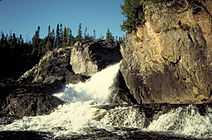Pukaskwa National Park
| Pukaskwa National Park | |
|---|---|
|
IUCN category II (national park) | |
 | |
| Location | Ontario, Canada |
| Nearest city | Marathon, Ontario |
| Coordinates | 48°14′44″N 85°53′18″W / 48.24568°N 85.88821°WCoordinates: 48°14′44″N 85°53′18″W / 48.24568°N 85.88821°W |
| Area | 1,878 km2 (725 sq mi) |
| Established | 1978 |
| Governing body | Parks Canada |
Pukaskwa National Park is a national park located south of the town of Marathon, Ontario in the Thunder Bay District of northern Ontario, Canada. Established in 1978, Pukaskwa is known for its vistas of Lake Superior and boreal forests. The park covers an area of 1,878 square kilometres (725 sq mi), and protects part of the longest undeveloped shoreline anywhere on the Great Lakes.
The Hattie Cove Campground is located at the north end of the park and can be accessed via Highway 627, the only road access into the park. There are also a number of backcountry campsites located along the 60km Coastal Hiking Trail which follows the north shore of Lake Superior. The Coastal Hiking Trail has two suspension bridges; one across the White River at Chigaamiwinigum and one across the Willow River. The Coastal Hiking Trail is part of the long-distance Voyageur Hiking Trail. Backcountry campsites are also located along the Coastal Paddling Route, the White River, and the Pukaskwa River.
A small population of Woodland Caribou can be found in the park. There are also black bears, moose, Canadian Lynx and grey wolves.
Climate
The park has a humid continental climate (Dfb) under the Köppen climate classification that is strongly influenced by Lake Superior.
| Climate data for Pukaskwa National Park (1981−2010) | |||||||||||||
|---|---|---|---|---|---|---|---|---|---|---|---|---|---|
| Month | Jan | Feb | Mar | Apr | May | Jun | Jul | Aug | Sep | Oct | Nov | Dec | Year |
| Record high °C (°F) | 6.0 (42.8) |
10.0 (50) |
17.0 (62.6) |
27.0 (80.6) |
29.0 (84.2) |
30.7 (87.3) |
30.5 (86.9) |
32.0 (89.6) |
25.3 (77.5) |
21.0 (69.8) |
16.5 (61.7) |
9.2 (48.6) |
32.0 (89.6) |
| Average high °C (°F) | −7.7 (18.1) |
−4.1 (24.6) |
0.6 (33.1) |
7.2 (45) |
13.5 (56.3) |
17.2 (63) |
19.5 (67.1) |
20.4 (68.7) |
15.8 (60.4) |
8.8 (47.8) |
1.9 (35.4) |
−4.2 (24.4) |
7.4 (45.3) |
| Daily mean °C (°F) | −13.5 (7.7) |
−10.1 (13.8) |
−5.3 (22.5) |
1.9 (35.4) |
7.8 (46) |
11.8 (53.2) |
14.4 (57.9) |
15.6 (60.1) |
11.6 (52.9) |
5.0 (41) |
−1.8 (28.8) |
−9.1 (15.6) |
2.4 (36.3) |
| Average low °C (°F) | −19.2 (−2.6) |
−16.1 (3) |
−11.1 (12) |
−3.4 (25.9) |
2.4 (36.3) |
6.3 (43.3) |
9.3 (48.7) |
10.7 (51.3) |
7.3 (45.1) |
1.2 (34.2) |
−5.5 (22.1) |
−13.9 (7) |
−2.7 (27.1) |
| Record low °C (°F) | −40 (−40) |
−39 (−38) |
−35 (−31) |
−21 (−6) |
−7.5 (18.5) |
−4.5 (23.9) |
−4.5 (23.9) |
−2.0 (28.4) |
−7 (19) |
−11.5 (11.3) |
−28.5 (−19.3) |
−39.5 (−39.1) |
−40 (−40) |
| Precipitation mm (inches) | 60.4 (2.378) |
32.7 (1.287) |
36.7 (1.445) |
41.7 (1.642) |
72.4 (2.85) |
84.5 (3.327) |
95.2 (3.748) |
75.9 (2.988) |
106.0 (4.173) |
90.8 (3.575) |
80.0 (3.15) |
59.8 (2.354) |
836.2 (32.921) |
| Rainfall mm (inches) | 0.64 (0.0252) |
1.8 (0.071) |
10.5 (0.413) |
34.3 (1.35) |
71.6 (2.819) |
84.5 (3.327) |
95.2 (3.748) |
75.8 (2.984) |
105.9 (4.169) |
83.5 (3.287) |
47.7 (1.878) |
5.1 (0.201) |
616.5 (24.272) |
| Snowfall cm (inches) | 59.8 (23.54) |
30.9 (12.17) |
26.3 (10.35) |
7.3 (2.87) |
0.88 (0.346) |
0.0 (0) |
0.0 (0) |
0.09 (0.035) |
0.13 (0.051) |
7.3 (2.87) |
32.3 (12.72) |
54.7 (21.54) |
219.7 (86.5) |
| Avg. precipitation days (≥ 0.2 mm) | 14.6 | 10.9 | 9.0 | 8.4 | 13.3 | 13.6 | 15.6 | 14.3 | 17.2 | 17.6 | 15.6 | 13.9 | 164 |
| Avg. rainy days (≥ 0.2 mm) | 0.42 | 0.58 | 1.8 | 7.3 | 12.9 | 13.6 | 15.6 | 14.2 | 17.2 | 16.2 | 7.6 | 1.0 | 108.4 |
| Avg. snowy days (≥ 0.2 cm) | 14.0 | 9.6 | 6.8 | 2.7 | 0.33 | 0.0 | 0.0 | 0.08 | 0.07 | 2.2 | 9.3 | 13.4 | 58.4 |
| Source: Environment Canada[1] | |||||||||||||
Rivers in the park include the:
- Pukaskwa River
- Cascade River
- North Swallow River
- Swallow River
- White River
- Willow River
The Pic River enters Lake Superior just north of the park.
The highest point in the park is the peak of Tip Top Mountain which rises to 641 meters / 2106 feet.[2]
Thousand year old rock structures known as Pukaskwa Pits which were created by the original inhabitants of this area can be found on many of the park's cobblestone beaches.
The most recent State of the Park Report for Pukaskwa National Park was published in 2008.
 Cascade River Falls |
 Horseshoe Bay on Lake Superior |
See also
| Wikimedia Commons has media related to Pukaskwa National Park. |
External links
- Official site
- Watch the short documentary by Bill Mason Pukaskwa National Park
- 2008 State of the Park Report
References
- ↑ "Pukaskwa National park". Canadian Climate Normals 1981–2010. Environment Canada. Retrieved September 29, 2013.
- ↑ Tip Top Mountain - Peakbagger.com
| ||||||||||||||||||||
| ||||||||||||||||||||||
